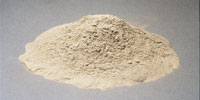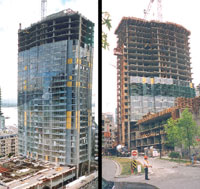
In the closely watched category of fly ash used in concrete, utilization in 2012 remained level at 11.8 million tons, up by 44,000 tons over 2011 and below 12.6 million tons in 2008. Its use is beneficial for a number of reasons. Since it is a by-product material, using it as a concrete ingredient provides economic advantages and frees up landfill space. In addition, fly ash promotes concrete workability, especially useful for pumped concrete mixtures. Fly ash reduces concretes’ permeability and increases its resistance to sulfate attack and alkali-silica reaction.
Cold weather and winter conditions can be challenging if concrete contains fly ash. Especially when fly ash is used at higher levels, problems are frequently encountered with extended setting times and slow strength development, leading to low early-age strengths and delays in the rate of construction. In addition, concretes containing fly ash are often reported to be more susceptible to surface scaling when exposed to deicing chemicals than portland cement concrete. It is therefore important to know how to adjust the amount of fly ash to minimize the drawbacks, while maximizing the benefits.
Optimizing the Amount of Fly Ash in Concrete—Bayview High-Rise Apartment Complex
The Bayview high-rise apartment complex was constructed in Vancouver, Canada, between 1999 and 2001 and consists of a 30-story residential tower and approximately 3,500 square yards of commercial space. The architect worked with EcoSmart, a government-industry consortium promoting the use of high-volume fly ash concrete, to increase the level of fly ash used in the project. The owner and contractor were both willing to use higher volumes of fly ash provided this did not increase the cost or require changes in construction practices (for example, changing the construction schedule). The amount of fly ash was optimized on the basis of the requirements of the concrete specification, the construction schedule and the temperature. For example, the amount of fly ash was limited to 20 percent in the slabs on grade because they were placed in the winter. A three-day tower cycle schedule was called for instead of the typical five-day cycle and, because of stripping and finishing delays often associated with concrete with high levels of fly ash, the contractor limited the amount of fly ash used in the suspended slabs. The project was considered a great success. The amount of fly ash used was increased on average by 13 percent over the contractor's standard practice for this type of construction (Busby and Associates).
construction schedule). The amount of fly ash was optimized on the basis of the requirements of the concrete specification, the construction schedule and the temperature. For example, the amount of fly ash was limited to 20 percent in the slabs on grade because they were placed in the winter. A three-day tower cycle schedule was called for instead of the typical five-day cycle and, because of stripping and finishing delays often associated with concrete with high levels of fly ash, the contractor limited the amount of fly ash used in the suspended slabs. The project was considered a great success. The amount of fly ash used was increased on average by 13 percent over the contractor's standard practice for this type of construction (Busby and Associates).
Bayview High-Rise Apartment in Vancouver, Canada (Courtesy: Busby and Associates)
Optimize Fly Ash Content for Cyclic Freezing and Thawing and Deicer Salt Scaling
Concrete containing fly ash is generally less resistant to scaling when subjected to freezing and thawing in the presence of deicer salts. The lower scaling resistance of fly ash concrete is more pronounced in lean concretes (low cementitious material content) or concretes with high levels of cement replaced with fly ash. Thomas (2007) summarized the following observations:
- Scaling of concrete containing fly ash increases as the water-to-cementitious materials ratio increases.
- Scaling generally increases with increasing fly ash content, especially at high levels of replacement (~40 to 50 percent).
- The use of curing compounds (membranes) reduces scaling; especially that of fly ash concrete.
Fly ash concrete is more likely to provide satisfactory scaling performance if the water-cementitious materials ratio does not exceed 0.45 and the level of fly ash does not exceed about 25 percent. This, of course, assumes an adequate air-void system is present in the concrete and that proper construction practices are adhered to.
Reference
Thomas, M. D. A., Optimizing the Use of Fly Ash in Concrete, IS548, Portland Cement Association, Skokie, IL, 2007, 24 pages.